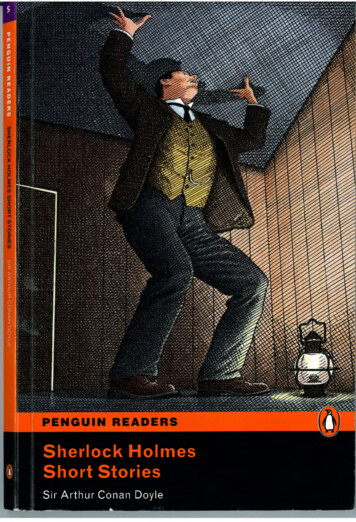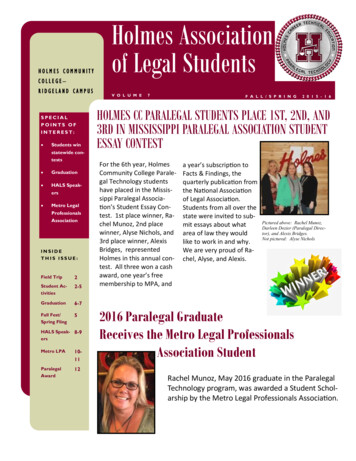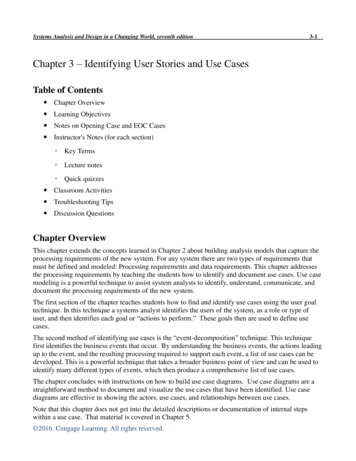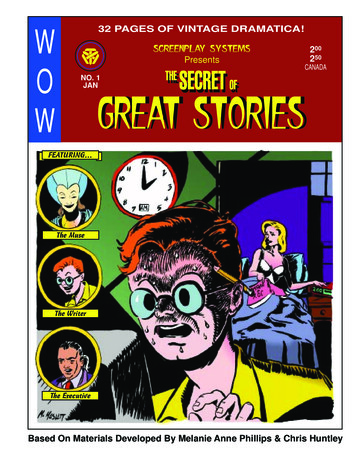
Transcription
Sherlock HolmesShort StoriesSir Arthu r Conan Doyle
Sherlock HolmesShort StoriesSIR ARTHUR CONAN DOYLELevel 5Selected and retold by Anthony LaudeSeries Editors: Andy Hopkins and Jocelyn Potter
Pearson Education Lim itedEdinburgh Gate, Harlow,Essex CM20 2JE, Englandand Associated Companies throughout the world.ISBN: 978-1-4058-6523-4First published in the Longman Simplified English Series 1977First published in the Longman Fiction Series 1993This adaptation first published in 1996First published by Penguin Books 1999This edition published 20087 9 10 8Original copyright The Copyright holders of the Sir Arthur Conan Doyle-works,reproduced by kind permission of Jonathan Clowes Ltd London,on behalf of Andrea Plunket, Trustee & AdministratorText copyright Penguin Books Ltd 1999This edition copyright Pearson Education Ltd 2008Typeset by Graphicraft Ltd, Hong KongSet in ll/14pt BemboPrinted in ChinaSWTC/07A ll rights reserved; no part of this publication may be reproduced, storedin a retrieval system, or transmitted in any form or by any means,electronic, mechanical, photocopying, recording or otherwise, without theprior written permission o f the Publishers.Published by Pearson Education Ltd in association withPenguin Books Ltd, both companies being subsidiaries of Pearson PicFor a complete list of the titles available in the Penguin Readers series please write to your localPearson Longman office or to: Penguin Readers Marketing Department, Pearson Education,Edinburgh Gate, Harlow, Essex CM20 2JE, England.
ContentsIntroductionThe Man with the Twisted LipThe Engineer s ThumbThe PatientThe Disappearance of LadyFrances CarfaxThe Three GarridebsWisteria HouseActivitiespagev12042537190111
IntroductionHe kept looking at the telegram. A t last, after lunch, he read it out loudto me:HAVE JU ST HAD A STRAN G E EXPERIENCE. M AY ICONSULT YOU? SC O TT ECCLES, PO ST OFFICE,CHARING CROSS.Is Scott Eccles a man or a woman?’ I asked.‘Oh, a man, of course! No woman would ever send a telegram likethat. A woman would have come straight to me.’All sorts of people visit Sherlock Holmes, the great detective,but they all have one thing in common: when they arrive at hisLondon address in Baker Street, they all need his help in solvingproblems that the police cannot help them with. There are fewcases that Holmes cannot solve. Fortunately for us, his friend andcolleague, Dr Watson, is always with him, taking notes. These areDr Watsons stories.Why has a woman’s honest, faithful, hard-working husbandsuddenly gone missing somewhere among the dangerous opiumhouses of East London? Why has an engineer lost his thumb,and why can’t he remember where it happened? Why is aquiet, harmless man suddenly filled with terror at the arrivalof a mysterious Russian lord? Why does Holmes send Watsonto Switzerland? Why does a bad-tempered American lawyersuddenly become friendly with an old bone-collector who livesalone? And why does a good-looking man from Spain invite astranger to his house on the night before he dies? Holmes enjoyssolving puzzles like these and, thanks to Watson’s notes, we canfollow each case step by step to its logical, and often unexpected,ending.
Before he became a writer, Conan Doyle studied medicine, andmuch of the character of Sherlock Holmes is taken from one ofhis teachers, Joseph Bell. When patients came to see him, Bellwas often able to give them information about their jobs, habitsand even their illnesses before they had said a word. He taughthis students the importance of small details, which is one of theskills needed by all great detectives. Sherlock Holmes is moreinterested in the activities of the brain and the use of faultlesslogic than in the imperfections of often illogical human emotion.He shows no interest in women and his only friend is Dr Watson,which makes him seem at times more like a machine than ahuman being.The reading public, however, were not interested in Holmes’sless attractive qualities. After two Sherlock Holmes novels, A Studyin Scarlet (1888) and The Sign of Four (1890), short stories aboutthe detective began to appear regularly in the Strand magazine,and Holmes quickly became a national hero. The magazine soldmore copies than it had ever done before. Much of the stories’success was due to Sidney Paget’s wonderful drawings of thegreat detective, which show him in his famous hat and smokinghis pipe —details which rarely appear in the stories themselves.The short stories in this collection all originally appearedin the Strand magazine: ‘The Man with the Twisted Lip’ inDecember 1891; ‘The Engineer’s Thumb’ in March 1892; ‘ThePatient’ (original title, ‘The Resident Patient’) in August 1893;‘Wisteria House’ (original title, ‘Wisteria Lodge’) in Septemberand October 1908;‘The Disappearance of Lady Frances Carfax’in December 1911; and ‘The Three Garridebs’ in January 1925.As these stories were written over such a long period, we cansee the relationship between Holmes and Watson changing overthe years. In the early stories, which are not included in thiscollection, Holmes and Watson are single men sharing rooms at221B Baker Street in London. Later, as in some of these stories,
Watson is not living with Holmes because he has married andhas his own medical practice near Paddington Station. WhenWatson’s wife dies, he returns to Baker Street.Despite the success of Sherlock Holmes, however, ConanDoyle dreamt of becoming a more ‘serious’ writer and ofwriting different types of books. After he had agreed to writea second series of stories for the Strand, therefore, he decidedthat his detective had to die. The last story in this second series,‘The Final Problem’ (December 1893), ends with Holmes inSwitzerland, fighting for his life with his greatest enemy, Moriarty.When Watson arrives, both men have disappeared. They have, itseems, both fallen to their deaths. The public were shocked andangry, unable to believe that their hero was dead. Conan Doylehimself was surprised by this reaction, but refused for severalyears to write another Sherlock Holmes story. In 1901, however,he changed his mind, and wrote The Hound of the Baskervilles. Hewas unwilling, however, to bring Sherlock Holmes back to life, sothe story took place before Holmes’s ‘death’ in Switzerland. WhenThe Hound of the Baskervilles appeared in August 1901, the Strandmagazine immediately sold 30,000 copies more than usual.Two years after the great success of The Hound of the Baskervilles,Conan Doyle really did bring Sherlock Holmes back to life. In1903, an American company offered him the enormous sum of25,000 dollars for six stories, and he could not refuse. In theshort story ‘The Empty House’, Holmes returns to Baker Street- to the great shock of Dr Watson! It seemed that only Moriartyhad died in Switzerland. Holmes had spent the next two yearstravelling because other enemies had also wanted to kill him. Thisdid not make much sense, but readers did not care. Their herohad returned, and nothing else mattered. After his third series ofadventures, The Return of Sherlock Holmes (1904), there was onefinal novel, The Valley of Fear (1915) and two more collections ofshort stories, His Last Bow (1917) and The Casebook of Sherlock
Holmes (1927).In total, Conan Doyle wrote four Sherlock Holmes novelsand fifty-six short stories. However, as we have already seen, hedid not want to be remembered only as the creator of SherlockHolmes. He wrote books of historical fiction, including TheExploits of Brigadier Gerard (1896) and The Adventures of Gerard(1896). He also wrote science fiction stories, the most famousof which is The Lost World (1912). His desire to escape theenormous success of Sherlock Holmes is perhaps understandable,but without Sherlock Holmes he would almost certainly not beremembered today.Sherlock Holmes is the most famous detective in the world,and is probably the best-known fictional character in literature.There have been hundreds of films about his stories, and manyactors have become famous for playing the part of SherlockHolmes. Perhaps one of the best was Basil Rathbone, who madefourteen Sherlock Holmes films for Hollywood between 1939and 1946.Arthur Conan Doyle was one of ten children, born into an Irishfamily in Edinburgh in 1859. His father, Charles Doyle, was anartist, but he drank too much and life was hard for the Doylefamily. Young Arthur was sent away to a Catholic school in thenorth of England, and rarely saw his father.From 1876 to 1881, Conan Doyle studied medicine at theUniversity of Edinburgh, then worked as a ship’s doctor on ajourney to the West African coast. In 1882, he started work as adoctor in Plymouth, but without much success. As his medicalwork did not keep him very busy, he amused himself by writingstories, the first of which was printed in Chambers’s EdinburghJournal before he was twenty.After a move to Southsea, he began to write more. His firstimportant work, A Study in Scarlet, appeared in Beeton’s Christmas
Annual in 1887. and introduced the reading public for the firsttime to Sherlock Holmes.In 1885, Conan Doyle married Louisa Hawkins, who diedin 1906. One year after his wife’s death, he married Jean Leckie,whom he had met and fallen in love with in 1897. Conan Doylehad five children, two with his first wife and three with hissecond.In 1891, he moved to London and, after a short time as anunsuccessful eye doctor, gave up all medical work to becomea full-time writer. Apart from his Sherlock Holmes stories andother fiction, he wrote a book about the war between the Britishand Dutch in South Africa, The Great Boer War (1900), defendingBritish action in South Africa at the time.Conan Doyle tried twice, without success, to become amember of the British parliament. He became a strong believerin equality for all under the law, and helped to free two men whohad been wrongly sent to prison. Important changes were thenmade to British law to make it more difficult for innocent peopleto be sent to prison. This story is told in Julian Barnes’s 2005novel, Arthur and George.After the deaths of his son, his brother and his two nephewsin World War I, Conan Doyle became interested in the spiritualworld and the search for scientific proof of life after death. Hedied in 1930, aged seventy-one. He had done many interestingthings in his life but, like Moriarty, had been unable to killSherlock Holmes. Even today, people write to Holmes’s BakerStreet address (now a bank), asking for the detective’s help andadvice. Sherlock Holmes never really existed, but he alwaysrefused to die. To his readers, he is still alive today - the greatestdetective that the world has ever known.
The Man with the Twisted LipMr Isa Whitney was, and had been for many years, an opiumaddict. He could not get rid of the habit. He had once been a fineman, but now people only pitied this bent, unfortunate personwith the yellow, unhealthy face. Opium was both his ruin and hisonly pleasure.One night in June, when it was almost time to go to bed, Iheard the doorbell ring. I sat up in my chair, and Mary, my wife,put her sewing down in annoyance.‘A patient!’ she said. ‘At this hour!’We heard the servant open the front door and speak tosomeone. A moment later the door of our sitting room wasthrown open and a lady came in. She wore a black veil over herface.‘Please forgive me for calling on you so late,’ she began. Butthen she could no longer control her feelings. She ran forward,threw her arms round Mary’s neck, and cried bitterly on hershoulder. ‘Oh, I’m in such trouble!’ she said. ‘I need help somuch!’‘Well!’ said my wife, pulling up the visitor’s veil. ‘It’s KateWhitney. This is a surprise, Kate! I had no idea who you werewhen you came in.’‘I didn’t know what to do, and so I came straight to you.’That was how it always happened. People who were in troublecame to my wife like birds to a lighthouse.‘We are very glad to see you,’ Mary said. ‘Now you must havesome wine and water, and sit here comfortably and tell us allabout it. Or would you like me to send John off to bed?’‘Oh, no, no! I want the doctor’s advice and help too. It’s about1
Isa. He hasn’t been home for two days. I’m so worried abouthim!’This was not the first time that Mrs Whitney had spoken to usof her husband’s bad ways: she and Mary had been at schooltogether. We did our best to calm her down and comfort her.‘Have you any idea where he has gone?’ I asked.‘Yes,’ Mrs Whitney replied. ‘He’s probably at a place called theBar of Gold, in East London, down by the river. It’s in UpperSwandam Street. It’s a place where opium addicts go. This is thefirst time that Isa has spent more than a day there.’I was Isa Whitney’s doctor and had a certain influence withhim.‘I will go to this place,’ I said. ‘If he is there, I will send himhome in a carriage within two hours.’Five minutes later I had left my comfortable chair and sittingroom and was in a fast carriage on my way east.Upper Swandam Street was on the north side of the river, tothe east of London Bridge. The Bar of Gold was below the levelof the street. Some steep steps led down to the entrance, whichwas little more than a hole in the wall. There was an oil lamphanging above the door. I ordered the driver to wait, and wentdown the steps.Inside, it was difficult to see very much through the thickbrown opium smoke. Wooden beds lined the walls of a long, lowroom. In the shadows I could just see bodies lying in strangepositions on the beds; and little red circles of light burning in thebowls of metal pipes. Most of the smokers lay silently, but sometalked softly to themselves. Near one end of the room was afireplace, in which a small fire was burning. A tall, thin old mansat there, his elbows on his knees, looking into the fire.A Malayan servant who belonged to the place came up to mewith some opium and a pipe. He pointed to an empty bed.‘No, thank you,’ I said.‘I haven’t come to stay.There is a friend2
of mine here, Mr Isa Whitney, and I want to
Level 5 Selected and retold by Anthony Laude Series Editors: Andy Hopkins and Jocelyn Potter. Pearson Education Limited Edinburgh Gate, Harlow, Essex CM20 2JE, England and Associated Companies throughout the world. ISBN: 978-1-4058-6523-4 First published in the Longman Simplified English Series 1977 First published in the Longman Fiction Series 1993 This adaptation first published in 1996 .











